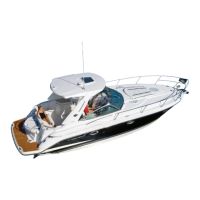
Do you have a question about the MONTGOMERY BOATS 340 SPORT YACHT and is the answer not in the manual?
| Brand | MONTGOMERY BOATS |
|---|---|
| Model | 340 SPORT YACHT |
| Category | Boat |
| Language | English |
Warranty details for the structural integrity of the hull and deck.
Transferable warranty for structural defects over ten years.
Warranty covering osmotic blisters on the hull for five years.
Warranty for exterior gelcoat defects like cracking or fading for two years.
Warranty for non-structural parts like canvas and upholstery.
Lists items and conditions excluded from warranty coverage.
Definitions of DANGER, WARNING, and CAUTION symbols used in the manual.
Information on boat registration and display of numbers.
Details on boat insurance responsibilities and types.
Procedures for reporting boating accidents and required forms.
Recommendations for boating safety courses and resources.
Information on mandatory safety equipment for boats.
Overview of the boat's propulsion system and engine manuals.
Details on transom-mounted outdrives, alignment, and corrosion.
Information on the exhaust system, hoses, and inspection.
Explanation of the raw water cooling system and freshwater cooling option.
Information on propeller types, pitch, and maintenance.
Factors affecting performance and propeller selection.
Description of gauges like tachometer, temperature, oil pressure, etc.
Overview of helm control systems: throttle, steering, trim tabs.
Details on cable and electronic throttle/shift controls.
Function and testing of the neutral safety switch.
Operation and adjustment of the outdrive's tilt and trim system.
Explanation of cable and hydraulic power assisted steering systems.
Operation and adjustment of trim tabs for hull attitude.
Maintenance procedures for control systems, steering, and trim tabs.
Overview of the fuel system, tanks, and withdrawal tubes.
Details on gasoline fuel tanks, filters, and anti-siphon valves.
Information on diesel fuel systems, filters, and contamination.
Fuel supply for the generator and its filter system.
Safe procedures for fueling the boat at a marina.
Routine inspection and maintenance of the fuel system.
Overview of AC and DC electrical systems on the boat.
Details on the 12-volt battery system, charging, and distribution.
Operation and location of remotely operated electric battery switches.
Description of helm switches for accessories like bilge pumps, lights, and wipers.
Location and function of DC breaker panels and individual breakers.
Overview of the AC system, shore power, and generator connection.
Description of the AC panel equipment and breakers.
Operation and maintenance of the onboard generator.
Purpose and maintenance of the boat's bonding system.
Procedures for maintaining 12-volt and AC electrical systems.
Table to document and manage AC accessory loads.
Overview of the fresh water system components and operation.
Filling the tank, priming the pump, and system operation.
Details on the 120-volt water heater and engine heat exchanger.
Connecting to shore water supply and its precautions.
Using the head compartment and transom showers.
Routine cleaning and maintenance of the fresh water system.
Procedure for sanitizing the fresh water system.
Overview of raw water systems and pump operation.
Details on the sea water cooled air conditioning system.
Procedure for cleaning the air conditioner's sea strainer.
Routine maintenance for the raw water system.
Overview of water drainage via overboard thru-hull fittings.
Operation of bilge pumps, float switches, and alarms.
Drainage systems for cockpit, engine compartment, and wet bar.
Drainage for galley, head sink, refrigerator, and sump systems.
Routine maintenance for all drainage systems.
Ventilation provided by deck hatches and exhaust blowers.
Hazards of carbon monoxide and importance of ventilation.
Engine compartment ventilation via free air and forced systems.
Maintenance for ventilation system components like hinges and ducts.
Rails, cleats, bow roller, anchor locker, and windlass.
Swim platform, transom storage, and hull maintenance.
Cockpit hatches, doors, engine access, and wet bar.
Features of the head compartment and VacuFlush marine head system.
Galley layout, sink, storage, and appliance integration.
Dinette, lounge seat, storage, lighting, and cabin breaker panel.
Operation and maintenance of the reverse cycle air conditioning unit.
Features of the master stateroom, including berth and amenities.
Description of the mid berth cabin area and its features.
Cleaning and maintenance of cabin floors, walls, cabinets, and trim.
Overview of safety equipment for enhancing boat operation.
Function of engine alarms for temperature and oil pressure.
Importance and function of the neutral safety switch.
USCG required safety items like PFDs, distress signals, and sound devices.
Operation of the engine compartment fire suppression system.
Function and importance of the CO detector.
Operator responsibility for first aid and required kit contents.
Recommended safety gear beyond legal requirements.
Examples and locations of safety labels on the boat.
Essential knowledge for operating the boat safely and responsibly.
Basic navigation rules for crossing, meeting, and overtaking situations.
Checklist of essential tasks before starting engines and cruising.
Procedures for starting engines, monitoring systems, and safe operation.
Techniques for maneuvering, securing, and anchoring the boat.
Actions to take if propulsion or steering systems fail.
Procedures following a collision, including passenger safety and damage checks.
Legal requirements and safe practices for assisting distressed vessels.
Steps to take if the boat becomes flooded or capsizes.
Operator responsibilities and considerations while fishing.
Procedures for recovering a person who has fallen overboard.
Regulations and practices for proper trash and waste disposal.
Guidelines and precautions for trailering the boat.
Hull cleaning, bottom paint, anodes, and gelcoat care.
Cleaning marine vinyl upholstery, canvas, and enclosures.
Cleaning wooden floors, carpets, headliners, and cushions.
Keeping bilge and engine compartments clean and protected.
Routine maintenance for cockpit, bilge, and cabin drains.
Procedures for preparing the boat for storage before hauling.
Safe practices for lifting and supporting the boat.
Steps for preparing the boat's systems for storage.
Detailed instructions for winterizing fresh water, raw water, and marine toilet systems.
Steps to reactivate the boat after winter storage.
Common problems and solutions for steering and throttle controls.
Troubleshooting for sluggish speed, RPM loss, and vibration.
Diagnosing issues like overheating, alternator failure, and starting problems.
Troubleshooting for common accessory issues like pumps and AC units.